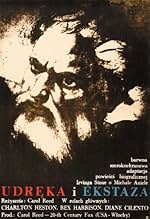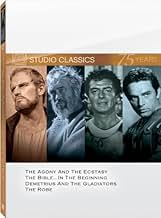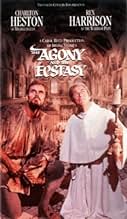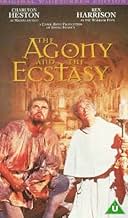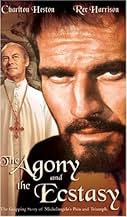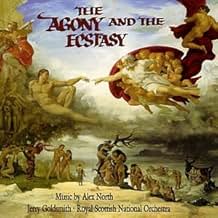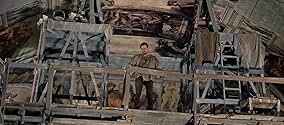NOTE IMDb
7,2/10
8,5 k
MA NOTE
Michel-Ange est chargé par le pape Jules II de peindre les fresques du plafond de la Chapelle Sixtine. Le peintre génial supporte mal le comportement despotique du pape. L'affrontement entre... Tout lireMichel-Ange est chargé par le pape Jules II de peindre les fresques du plafond de la Chapelle Sixtine. Le peintre génial supporte mal le comportement despotique du pape. L'affrontement entre les deux grands hommes est inévitable.Michel-Ange est chargé par le pape Jules II de peindre les fresques du plafond de la Chapelle Sixtine. Le peintre génial supporte mal le comportement despotique du pape. L'affrontement entre les deux grands hommes est inévitable.
- Réalisation
- Scénario
- Casting principal
- Nommé pour 5 Oscars
- 3 victoires et 9 nominations au total
Fortunato Arena
- Pope's Bodyguard
- (non crédité)
Lars Bloch
- Baron Von Silenen
- (non crédité)
Angelo Boscariol
- Papal Guard
- (non crédité)
Calisto Calisti
- Physician
- (non crédité)
Amerigo Castrighella
- Quarry cart assistant
- (non crédité)
Anita Ceccotti
- Woman Under the Chapel
- (non crédité)
Enrico Chiappafreddo
- Tavern Customer
- (non crédité)
Avis à la une
I would be more generous than Maltin was with this one. I watched it again recently on tape and my impression improved over my first viewing. The production values are sumptuous, and the construction of a 1:1 mockup of the Sistine Chapel by Dino deLaurentis is a story in itself, evidently. Heston is pretty good as Michelangelo but is, I think, overshadowed by Harrison, who is just marvelous as Pope Julius (a previous commenter remarked on the historically inauthentic absence of his beard; in addition, Julius was too old & infirm too ride a horse into battle, but insisted on leading while carried on a litter). The conflicted interplay between Julius & Michelangelo is the core of the film, of course, and the script does its job well in this regard, particularly in the closing dialogue. It is interesting, though, to see how the movie dances around the issue of Michelangelo's purported homosexuality. We are so much more frank today (not necessarily for the better), and one shudders to consider how a contemporary movie would treat this subject (not that there's a chance in hell of a major movie being made today on the subject of the creation of one of the masterworks of the West's artistic inheritance). If any movie definitely needs the letterbox format to show it off at its best, it is this one, so watch for it on TMC where it is often shown that way.
The picture deals with Michelangelo or Michael Angel (Charlton Heston) who is working on the Carrara's marble creating sculptures and he is then ordered by Pope Julius II (Rex Harrison) the painting of as called Sistine chapel (that's why it was built by Pope Sisto) . Meanwhile , they'll develop various relationships with other Renaissance's important people . The film is correctly based on historical deeds and appearing famous roles , such as : Raphael (Tomas Milian) who shows up painting the ¨Athenas' school¨, Bramante (Harry Andrews) builder of the Vatican dome that hold his name , Girlandaio , Florence Medicis' descendants (Diane Cilento and Adolfo Celi) and duke of Urbin (Alberto Lupo). Besides , the film paces itself the confrontation between Julius II troops and the French/German army for the possession of the Pope's states . There are epic and impressive battles where the Pope himself fights enemies . The motion picture describes specially the creation of the enormous paintings on the ceiling and the difficulties that Michael Angel is suffering to achieve the immortal legacy . The Pope Julio II will also assign him the realization of his tomb .
The feature movie obtained a limited success and had a moderated box-office ; however , being nowadays better valued than the past . First-range acting by the two main actors : Charlton Heston and Rex Harrison , both of whom are magnificent . However , Rex Harrison did not get along with Charlton Heston at all during shooting ; in fact , twelve years later, while filming as secondary actors ¨Crossed swords¨ (1977) directed by Richard Fleischer , Rex avoided him utterly . Leon Shamroy's cinematography is rousing , the colorful paintings are glowing and brilliant ; spectacularly showing Bible's scenes at the Sistine Chapel . Alex North musical score is riveting (like ¨Spartacus¨ who he equally composed) . The sets are overwhelming and breathtaking , they were stunningly designed by production designer John De Cuir . In addition , evocative as well as adequate costumes by Oscarized Vittorio Nino Novarese . Carol Reed production and direction were excellent , he'd got much experience through a long career and had directed other classic movies (The third man) . Rating: Very good , above average and well worth seeing.
The feature movie obtained a limited success and had a moderated box-office ; however , being nowadays better valued than the past . First-range acting by the two main actors : Charlton Heston and Rex Harrison , both of whom are magnificent . However , Rex Harrison did not get along with Charlton Heston at all during shooting ; in fact , twelve years later, while filming as secondary actors ¨Crossed swords¨ (1977) directed by Richard Fleischer , Rex avoided him utterly . Leon Shamroy's cinematography is rousing , the colorful paintings are glowing and brilliant ; spectacularly showing Bible's scenes at the Sistine Chapel . Alex North musical score is riveting (like ¨Spartacus¨ who he equally composed) . The sets are overwhelming and breathtaking , they were stunningly designed by production designer John De Cuir . In addition , evocative as well as adequate costumes by Oscarized Vittorio Nino Novarese . Carol Reed production and direction were excellent , he'd got much experience through a long career and had directed other classic movies (The third man) . Rating: Very good , above average and well worth seeing.
like many historical films from the same age of Hollywood, the word "impressive" is the first to say. not only for its status of epic drama, costumes and the translation in image of a period. but, maybe , more important, for the admirable clash between Rex Harrison and Charlton Heston. and for the feel than a great story has its right and fair adaptation. because something impose "The Agony and the Ectasy" as special. not the biography of a great artist - and the admirable virtue is to know than Heston is Michelangelo not only act him - but the chance to discover yourself. the film, like the book, it is a beautiful eulogy to the life. using a genius as character of a kind of parable about art, proud, honesty and desire. so, just impressive. in this case - a word with deep roots.
The Agony and the Ecstasy is the story of the creation of the Sistine Chapel Roof painting, the time and money it took while Pope Julius II was busy establishing his Papacy as a political force.
Back in those days the Pope was far more than the head of the Roman Catholic Church. He ruled a considerable piece of real estate in the center of the Italian peninsula that were called the Papal States. They varied in geographic size depending on how relatively strong the Pope or his enemies were at a given time. The Papal States were the last independent entity to join a united Italy in 1870.
The Borgias had been nibbling away at the Papal States for years and their triumph became complete when one of their's became Pope Alexander VI in 1491. When Giuliano Della Rovere became Julius II in 1503 succeeding Alexander VI he had it in mind to reclaim the states from the Borgias and their backer the French monarchy. Those are the folks you see Rex Harrison fighting at the beginning of the film.
In fact Harrison's identity as the warrior Pope is made clear right at the beginning of the film when after we see this figure on a white horse killing some foes in battle, he takes off his helmet and some attendees put his papal vestments right over his armor.
But Julius II wanted to be known as a patron of the arts as well as the warrior Pope. His uncle Pope Sixtus VI had built the Sistine Chapel which is today the personal chapel of the papal residence. According to Wikipedia its dimensions are exactly what the Bible lays down as the dimensions King Solomon built his temple. But who knows what Solomon had decorating his roof.
It's a big bare spot and who to fill it with something good. Julius II decided on Michelangelo Buonarrati who's got quite a resume of creativity to recommend him even though it's mostly sculpture.
The film is the story of the creative differences between Michelangelo and Julius. Michelangelo is knowing he's created something for the ages, but he won't see the big picture of the here and now of Renaissance European politics which Julius II has to deal with.
Sir Carol Reed directed The Agony and the Ecstasy and does a marvelous job of creating the look and atmosphere of the Renaissance in Italy. Charlton Heston and Rex Harrison playing Michelangelo and the Pope give outstanding performances.
If the film has a weakness is that it really is a two man show with no other characters developed in any way. The rest of the mostly Italian cast just serve as a crowd.
If you're either a patron of the arts or a Catholic who would like to know how the Sistine Chapel acquired its legendary roof than by all means see The Agony and the Ecstasy.
Back in those days the Pope was far more than the head of the Roman Catholic Church. He ruled a considerable piece of real estate in the center of the Italian peninsula that were called the Papal States. They varied in geographic size depending on how relatively strong the Pope or his enemies were at a given time. The Papal States were the last independent entity to join a united Italy in 1870.
The Borgias had been nibbling away at the Papal States for years and their triumph became complete when one of their's became Pope Alexander VI in 1491. When Giuliano Della Rovere became Julius II in 1503 succeeding Alexander VI he had it in mind to reclaim the states from the Borgias and their backer the French monarchy. Those are the folks you see Rex Harrison fighting at the beginning of the film.
In fact Harrison's identity as the warrior Pope is made clear right at the beginning of the film when after we see this figure on a white horse killing some foes in battle, he takes off his helmet and some attendees put his papal vestments right over his armor.
But Julius II wanted to be known as a patron of the arts as well as the warrior Pope. His uncle Pope Sixtus VI had built the Sistine Chapel which is today the personal chapel of the papal residence. According to Wikipedia its dimensions are exactly what the Bible lays down as the dimensions King Solomon built his temple. But who knows what Solomon had decorating his roof.
It's a big bare spot and who to fill it with something good. Julius II decided on Michelangelo Buonarrati who's got quite a resume of creativity to recommend him even though it's mostly sculpture.
The film is the story of the creative differences between Michelangelo and Julius. Michelangelo is knowing he's created something for the ages, but he won't see the big picture of the here and now of Renaissance European politics which Julius II has to deal with.
Sir Carol Reed directed The Agony and the Ecstasy and does a marvelous job of creating the look and atmosphere of the Renaissance in Italy. Charlton Heston and Rex Harrison playing Michelangelo and the Pope give outstanding performances.
If the film has a weakness is that it really is a two man show with no other characters developed in any way. The rest of the mostly Italian cast just serve as a crowd.
If you're either a patron of the arts or a Catholic who would like to know how the Sistine Chapel acquired its legendary roof than by all means see The Agony and the Ecstasy.
The film is an epic grandeur feature of a interpersonal tug-of-war between the maestro Michelangelo and Pope Julius II.
I cannot help being shell-shocked to see the reconstruction of the magnificent ceiling though recognizably most of which is the trickery of montage (not in the real the Sistine Chapel, the location was inside Cinecitta Italy instead), but bathing under the glamour and solemnness of the visual wonders, I am stunned to exude my admiration and awe!
The two leads conspicuously stimulate a Moses versus Caesar confrontation, Charlton Heston seems to be more boorish than artistic to manifest a struggled Michelangelo, may God doesn't distinguish his people by their looks. The "agony and ecstasy" is watered down to an underwhelming stalemate thanks to Charlton's outlandish incarnation as the most eminent artist of that time. Rex Harrison, is by far and large worthy another Oscar nomination for his arresting devotedness, which is apt to impress the audience with a mind-blowing bi-polar characterization while good and evil coexist at the same time.
The film was a grave box office fiasco when it came out in 1965, however, judging by my appraisement, its merits still can be appreciated by our generation (a well-balanced script, the haunting original score and all the props and settings). However, the film entirely skipped Michelangelo's sexual orientation and awkwardly ploys a portentous conversation between Michelangelo and his admirer Contessina de'Medici (a over-wise Diane Cilento), which unveiled its cowardliness and helplessness.
My final remark is that as time goes by ruthlessly, art stands still and never fades away, so lucky enough cinema is yet a part of it.
I cannot help being shell-shocked to see the reconstruction of the magnificent ceiling though recognizably most of which is the trickery of montage (not in the real the Sistine Chapel, the location was inside Cinecitta Italy instead), but bathing under the glamour and solemnness of the visual wonders, I am stunned to exude my admiration and awe!
The two leads conspicuously stimulate a Moses versus Caesar confrontation, Charlton Heston seems to be more boorish than artistic to manifest a struggled Michelangelo, may God doesn't distinguish his people by their looks. The "agony and ecstasy" is watered down to an underwhelming stalemate thanks to Charlton's outlandish incarnation as the most eminent artist of that time. Rex Harrison, is by far and large worthy another Oscar nomination for his arresting devotedness, which is apt to impress the audience with a mind-blowing bi-polar characterization while good and evil coexist at the same time.
The film was a grave box office fiasco when it came out in 1965, however, judging by my appraisement, its merits still can be appreciated by our generation (a well-balanced script, the haunting original score and all the props and settings). However, the film entirely skipped Michelangelo's sexual orientation and awkwardly ploys a portentous conversation between Michelangelo and his admirer Contessina de'Medici (a over-wise Diane Cilento), which unveiled its cowardliness and helplessness.
My final remark is that as time goes by ruthlessly, art stands still and never fades away, so lucky enough cinema is yet a part of it.
Portrayals of the Pope On Screen
Portrayals of the Pope On Screen
Take a look at actors who have portrayed the Pope in movies and on television. And no, we're not going to spoil Conclave if you haven't watched it yet.
Le saviez-vous
- AnecdotesThe book on which this movie is based covers the entire life of Michelangelo Buonarroti. This movie based on a single chapter. One of the shortest, if not the shortest, in the entire book.
- GaffesAs shown in the movie, Michelangelo created a flat wooden platform on brackets built out from holes in the wall, high up near the top of the windows. But contrary to what is depicted in the film, he did not lie on this scaffolding while he painted, but painted from a standing position.
- ConnexionsEdited from Prologue: The Artist Who Did Not Want to Paint (1965)
Meilleurs choix
Connectez-vous pour évaluer et suivre la liste de favoris afin de recevoir des recommandations personnalisées
- How long is The Agony and the Ecstasy?Alimenté par Alexa
Détails
- Date de sortie
- Pays d’origine
- Langues
- Aussi connu sous le nom de
- La agonía y el éxtasis
- Lieux de tournage
- Piazza del Popolo, Todi, Perugia, Umbria, Italie(St. Peter's Square scene)
- Société de production
- Voir plus de crédits d'entreprise sur IMDbPro
Box-office
- Budget
- 10 000 000 $US (estimé)
- Durée2 heures 18 minutes
- Couleur
- Rapport de forme
- 2.20 : 1
Contribuer à cette page
Suggérer une modification ou ajouter du contenu manquant

Lacune principale
What is the Japanese language plot outline for L'extase et l'agonie (1965)?
Répondre

